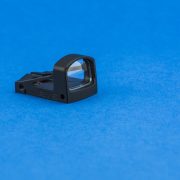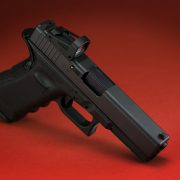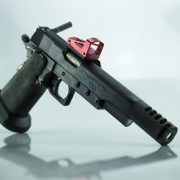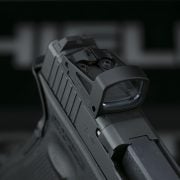It seems that the red dot on handgun debate is raging as hard as the caliber debate. Proponents argue that the red dot is more “accurate” or at least allows for more precise shots. Opponents would state that it is slower to get shots on target due to the time needed to acquire the dot. I’m just over here thinking that the dot turns my world blue, so I don’t like them.
Don’t get me wrong, I recognize their utility, especially in light of Aaron Cowan’s of Sage Dynamics detailed analysis available here: http://docs.wixstatic.com/ugd/7dc128_c8da57977a8c4b53903192fa603fce6f.pdf
Still, the various offerings have their own set of issues. Sights are wider than the slides, their reflective lens coatings color-shift the target, they require suppressor sights to co-witness, robustness, and/or having to remove the sight from the weapon to change a battery. Each reason alone is enough to turn a shooter off to them, if its important enough.
So, what would happen if a sight solved these issues? Will it make the sight pistol optics nirvana?
Enter the Shield RMS – Reflex Miniature Sight
Those versed in weapons configurations beyond the United States’ shores will immediately recognize the name Shield. With only a small presence and following in America, Shield has been steadily growing across the international markets, especially with the UK military. Their SMS sight adorns over 15,000 weapons on active duty – not including worldwide civilian sales.
Shield was and still is an active part of the US Market, just not use using the Shield name. An earlier generation of sight is imported and sold under the JP Enterprises J-Point moniker. Anyone knowing John Paul, would see this as a large stamp of approval. JP does not put their name on sub-par offerings.
The JPoint (or Shield Mini Sight) is a polymer offering, which has been bemoaned by those “knowing better.” I would assert that those chair commandos do not have much experience with the sight – those I know shoot with them, love them. The sights perform excellent, but did not solve all the problems of the modern shooter.

The SMS or JPoint
Enter the RMS, which is functionally the second-generation and improved upon SMS. The RMS moves to aluminum construction, but keeps the clear polycarbonate lens and form factor that made the SMS so loved. From there, the sight updates on other items including a battery drawer that does not require the optic to be removed from the mount to change and better battery life.
Those change are all it took to make a good optic into a great one.

The RMS. Note the “hollow” support struts for the lens.
The Sight – TECHNICAL SPECIFICATIONS (From Shield):
OPTICAL CHARACTERISTICS
- Light Source: Red light emitting diode (LED) No laser; completely eye safe No radioactive materials
- Red Dot Size Options: 4 MOA dot8 MOA dot
- Lens: Reflex x1 (no magnification)
- Lens Coating: Anti-reflectionNo coloured coating, minimises visible signature
ELECTRONICS
- Battery: One 3V lithium battery, CR2032
- Battery Life: 2 to 3 years – average use >4 years – dark storage
- Brightness Adjustment: Automatic
- Brightness Range: Lowest – Compatible with Night Vision: Highest – Visible against the sky in bright daylight
EXTERIOR
- Housing material: Aluminium
- Colour: Matte black
- Dimensions: Sight only (Length x width x height) 42 x 25 x 23 mm 1.7 x 1.0 x 0.9 inches
- Weight: 17.5 grams / 0.61 ounces
- Mount: A wide range of mounts are available.
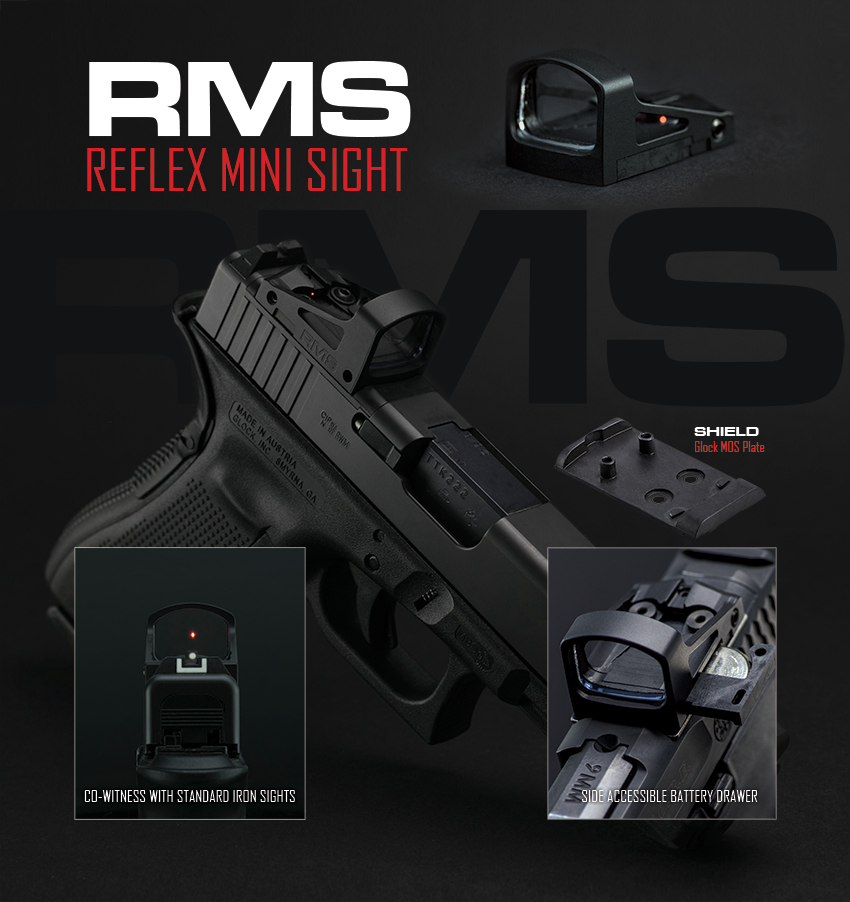
At the Range
Author’s Note – The Shield RMS was provided on loan from a Shield marketing rep mounted to a Tharros G17 glock slide. Testing was conduced using this slide on a Lone Wolf Timberwolf frame. The optic and slide were returned upon completion of testing.
Technical specifications can be dry reading, but their impact at the range is easy to see, especially when mounted up with sights on target. The lightweight (just over ½ ounce) body is not even noticeable on a loaded handgun and the clear poly lens is “meh” until one sets it on a target. No more color shift due to reflective filters – just pure sight picture, sight alignment. On a personal level, I cannot overstate how paradigm shifting this was to my understanding of red dots.
The model sent to me had the 4 MOA dot (8 MOA is optional) which is self-adjusting to the ambient light. There is no on-off switch. If the battery is in, the optic is on and adjusting. At first, I thought this a major negative, but after a week with it on, not having to worry about settings was a relief – so long as the dot adjusted correctly – which it did.
Typically, I am wary of self-adjusting optics. Almost invariably, those models have major issues from shooting from dark light into high light and vice versa. The Shield RMS did not – if only because it defaults to being a bit brighter than one is used to. This leads to some fuzzy outline on the dot when shooting into low-light, but not so much as to be distracting. Its bright that the 4 MOA goes to 8. On the converse, the optic is bright enough in low-light that shooting to high makes the dot a fine circle. While not tested with night vision – Shield states the dot will adjust to night-vision compatible in suitable environments.
The RMS was shipped mounted to a Tharros Glock 17 slide – perhaps the most attractive aftermarket slide out there (at least to HALO fans). Tharros perfectly melded the optic to the slide and included some excellent black iron sights on the frame – which I promptly removed. The RMS maintains the SMS’ notable feature – a built-in rear iron sight notch that can be used for a lower ¼ iron sight picture with many stock sights. Grabbing one of my many removed stock Glock sights, I found it shooting a tad low with the irons versus the dot – a function of how well Tharros mounted the slide. The MOS mount will likely be perfect, as the sight sits higher on the slide. The key take-away, no rear sight is needed when a RMS is mounted – Walther shooters rejoice.

Putting rounds down range is as easy as put the sight on the target and pull the trigger. When using the Glock front sight, I especially liked the rear notch. As one who practices finding the dot by establishing the iron sight picture, the integrated sight is a real benefit. Even re-mounted with the taller aftermarket sights, it worked well – I just did not like the taller irons taking up more of the sight picture – not the fault of the RMS.
As with any sight mounted to the slide, it takes practice to follow the dot during recoil and reset for follow-up shots. At first, the bouncing red dot is unnerving, but with a hundred rounds down the pipe, it becomes comforting to watch the weapon’s behavior and track the dot back onto the target – a big boon over standard irons which require getting the rear sight back into focus as well. For close-in targets, I did not see much improvement oinsplits or accuracy, but targets 15 yards and out, the RMS shined bright like the red dot. Full-size IPSC steel became a joke and only at 100 where the bullet drop factored in heavily did the dot show its limitations – which was still better than trying to off-set with irons where the target would be fully obscured. The RMS allows one to see distant targets and take aimed shots where the only guess is drop.
My Idiocy & The RMS’ Durability
Halfway through testing, I took the slide off the frame to take it into the office to share with a few fellow enthusiasts. Being human, I forgot that the sight was in my briefcase when I headed out to vacation a week later and the TSA and local constabulary had a bit of an infarction. No, I did not take a gun through TSA (that would be very bad), I did have a part where the officers gave me a choice – remove the slide from the airport (like, right now) or surrender it and face charges. It was an easy choice.
The irony is, I had a firearm in my checked baggage.
With my wife’s and multiple officer’s disapproving looks, I raced out of the checkpoint to dispose of the slide. Unfortunately, the airport in question did not have one of those “ridiculous overcharging to ship something home” stations, so with the help of a kiosk shop owner, I threw the slide into a standard envelop – no padding – slathered it in stamps, and hoped for the best.
Arriving home, I found the slide in the envelope, taped by by a postal employee after it likely fell out, sitting in my mail. Almost betting that the optic was beaten to a pulp, I opened it up to find the RMS brightly shining. The optic survived the USPS. Unpadded. And it retained zero. Wow.
Finishing Up Testing & EDC
After the USPS incident, I went back to the range to test the optic with +P carry ammo as I was curious to carry it EDC with my normal defensive ammo. After gobbling up another 200 rounds, I was comfortable that weapon was good with the ammo and the optic was up to the challenge of carry. Thus, in a Bravo Concealment holster, into the carry rotation it went.
During it, I noticed that those never noticed that I had an optic on the gun. With normally astute co-workers (who all carry as well), we tend to see who has an optic due to printing of the wider optic lens compared to the slide. No one noticed – which is a real-world back-up to the RMS’ form factor. The width is dead-even with the slide. Where RMRs are wider and various others have flared optics, the RMS’ slim form-factor is easy to conceal.

EDC draw drills were a breeze with no snagging on clothes. The RMS’ lens support arms clear away articles easily with no ledge for anything to get caught on. Even going time between drills, and weeks between range sessions, I was able to clearly pick up the dot. I did not find the dot slow me down and only made me more accurate at longer shots. It took my Glock 17 and turned it into a sniper pistol.
The Good:
- Clear polycarbonate lens with no color aberration.
- Bright dot, even in under bright daylight.
- Aluminum housing took an absolute beating with no loss in zero.
- Slimmer width to match handguns without additional printing.
- Includes rear iron sight notch.
The Notable:
- Not a whole lot of support from slide manufacturers, but does fit “Delta Point” adapters (just with a little gap).
- For Glock MOS handguns, Shield includes an MOS adapter.
- Available in a 4 MOA and 8 MOA dot configurations.
- Various mounts available directly from Shield (but have to come over from the UK)
- Unproven track record over extreme long term duty use – but promising results thus far.
The Bad:
- Relatively hard to find here in the USA. Network is growing.

Final Thoughts:
After having run this RMS through the wringer, I am convinced that the Shield is the best red dot sight for a handgun on the market. Its tough (and by that I mean can survive the USPS without any padding!), reliable across the 1,200 rounds fired so far, and utterly user-friendly. No settings to fiddle with, just mount and go.
Unlike other sights out there, the RMS was built from the ground up to be mounted to and work on violent handgun slides. From the battery mounting that does not require removal from the slide, to the clear polycarbonate lens, and integrated iron sight, the dedicated design glows as bright as the red dot.
Simply put, the RMS is what the RMR wishes it was. It settles the red dot debate, at least for me, without reservation. I contend this RMS needs to be put through Sage’s paces – I have no doubt its “duty” ready.
The RMS is utterly fantastic, just wish it was easier to find here in the US – which is in my opinion the only thing Shield needs to work on.
 Your Privacy Choices
Your Privacy Choices




